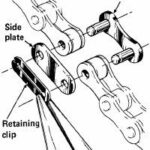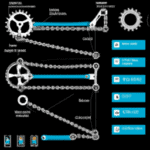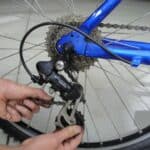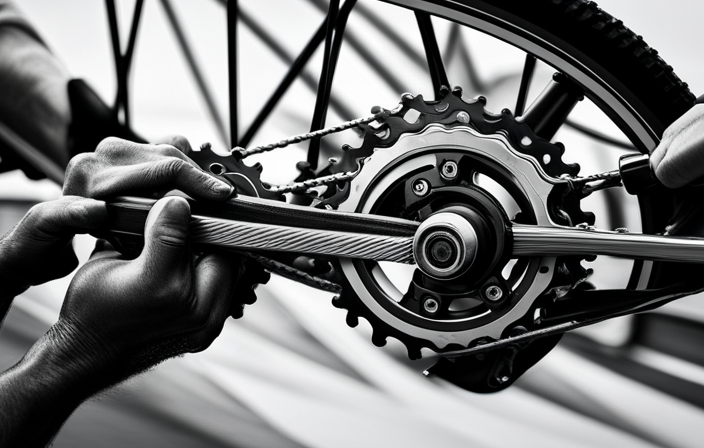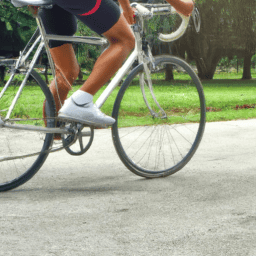Are you frustrated with the perpetual rubbing of your bicycle chain against the derailleur, leading to those irritating clicking noises and subpar gear shifts? Or perhaps your chain has stretched beyond its ideal length, and you’re considering eliminating a link to restore optimal tension? Regardless of the cause, for those who haven’t attempted this before, the idea of taking out a link from a bike chain can appear intimidating.
But fear not, with the right tools and a little bit of patience, you can easily remove a link and get your chain back to working like new.
In this article, we will guide you through the step-by-step process of removing a link from a bicycle chain. We will explain the necessary tools and materials you will need, where to locate the chain breaker tool, how to break the chain, remove the unwanted link, and finally, reconnect the chain.
By the end of this article, you will be equipped with the knowledge and skills to confidently remove a link from your bicycle chain and get your ride back to its smooth, silent self.
So, let’s get started!
Key Takeaways
- Removing a link from a bicycle chain requires the right tools and patience.
- Proper lubrication and regular maintenance can prevent chain wear and breakage.
- Shortening the chain can improve performance and shifting.
- Reconnecting the chain involves properly inserting and securing the replacement link.
Gather the Necessary Tools and Materials
You’re going to need a few tools and materials to get started on removing that link from your bicycle chain. First, you’ll need a chain breaker tool, which allows you to push the pins that hold the chain links together.
You’ll also need a pair of pliers to help remove the chain, a rag to clean any grease or dirt off the chain, and a lubricant to prevent chain wear. Choosing appropriate lubrication is important because it prevents the chain from wearing out too quickly. Make sure to choose a lubricant that’s specifically designed for bicycle chains.
Additionally, you should prevent chain wear by cleaning and lubricating your chain regularly. Now that you have all the necessary tools and materials, it’s time to locate the chain breaker tool.
Locate the Chain Breaker Tool
Once you’ve secured the necessary tool, it’s important to note that approximately 80% of bike chain issues can be resolved by simply cleaning and lubricating the chain. However, if you need to remove a link from your bicycle chain, you’ll need to locate a chain breaker tool. This tool is specifically designed to break the chain, allowing you to remove or add links as needed.
Using a chain breaker tool effectively is crucial to avoiding common mistakes when using the tool. Here’s a quick guide to using a chain breaker tool:
| Step | Action |
|---|---|
| 1 | Position the chain in the tool |
| 2 | Adjust the tool to the right size |
| 3 | Tighten the tool until the pin is touching the chain |
| 4 | Turn the handle to push the pin out |
| 5 | Remove the link and reassemble the chain |
It’s important to note that pushing the pin out too far can damage the chain, so be sure to only push it out as far as needed to remove the link. With the chain breaker tool in hand, you’re ready to break the chain and remove the link you need.
Break the Chain
To break the chain on your bike, simply position it in the chain breaker tool and adjust it to the correct size before tightening and turning the handle to push the pin out. Make sure you have a good grip on the chain to prevent it from slipping out of the tool.
Using alternative methods such as pliers or a hammer and nail to remove the pin may seem easier, but it can damage the chain and weaken it over time. It’s best to use a chain breaker tool for a clean and safe removal.
Preventing chain breakage is important to ensure the longevity of your bike’s chain. Regularly clean and lubricate the chain to reduce friction and wear. Avoid shifting gears when pedaling hard, as this can cause stress on the chain. Additionally, avoid standing on the pedals when going uphill, as this can also put extra strain on the chain.
By taking these precautions, you can prevent the need for frequent chain replacements. To remove the unwanted link, continue to the next section.
Remove the Unwanted Link
By breaking the chain at a certain point, you can shorten the length of your bike’s chain and improve its performance. However, after breaking the chain, you may find that the new length is still too long.
In this case, you’ll need to remove an unwanted link from the chain. Chain maintenance is an important part of keeping your bike running smoothly. Removing a link can help to improve the shifting and overall performance of your bike.
Some common reasons for removing links include fixing a broken chain, adjusting the chain length to fit a new bike frame, or simply wanting to remove a worn-out link that is causing the chain to skip. Whatever the reason, it’s important to carefully remove the unwanted link using a chain tool. Make sure not to damage any of the other links in the process.
Once you have successfully removed the link, you can then reconnect the chain to its new, shorter length.
Reconnect the Chain
Now that you’ve successfully removed the unwanted link from your bicycle chain, it’s time to reconnect it.
The first step is to insert the replacement link into the chain. Ensure that the pins are facing the correct way before closing the link.
Then, use a chain tool to push the pins in place.
Insert the Replacement Link
Simply slide the replacement link onto the chain and snap it into place, feeling the satisfaction of a job well done as your bike is ready to ride again. However, before inserting the link, make sure the chain has been properly lubricated to prevent unnecessary wear and tear. Also, ensure the replacement link matches the chain size for a proper fit.
To insert the replacement link, follow these steps:
- Align the replacement link with the chain.
- Slide the pins into the holes on the chain.
- Use a chain tool to push the pins in until they snap into place.
- Give the chain a tug to ensure it is securely connected.
With the replacement link properly inserted, you can now move on to reconnecting the chain.
Reconnect the Chain
Next up, it’s time to put the chain back together and get your bike back on the road. First, make sure that the replacement link is properly inserted and secured. Then, reconnect the chain by following these steps:
| Step | Action |
|---|---|
| 1 | Hold the chain ends together, with the replacement link at the bottom. |
| 2 | Position the chain tool on the chain pin that is closest to the replacement link. |
| 3 | Tighten the chain tool until the pin is fully inserted into the chain link. |
| 4 | Loosen the chain tool and remove it from the chain. |
Now that the chain is reconnected, it’s important to perform proper lubrication and chain maintenance. Apply a lubricant to the chain and make sure it is evenly distributed. Wipe off any excess lubricant with a clean rag. Regularly clean and lubricate your chain to prevent rust and wear. Additionally, check the tension of your chain and adjust it as necessary to ensure optimal performance. By taking these steps, you can ensure that your bike chain will stay in good condition and perform well for many rides to come.
Frequently Asked Questions
What should I do if I accidentally break the wrong link in the chain?
If you break the wrong link, repairing damaged links requires a chain tool. Best practices for chain maintenance include regular cleaning and lubrication. Always double check before breaking a link, and consider seeking professional help if necessary.
Can I use a different tool besides a chain breaker to remove a link?
Using pliers or a hammer and nail can be alternative methods to remove a link from a bicycle chain, but there are potential risks such as damaging the chain or causing injury. A chain breaker is the recommended tool for safe and precise removal.
Is it possible to remove multiple links at once?
Removing multiple links at once is not recommended for chain maintenance due to the risk of damaging the chain. Chain wear and tear can be reduced by regularly cleaning and lubricating the chain, and replacing worn out parts.
Will removing a link affect the overall length and tension of the chain?
Like a symphony, chain maintenance requires precision and attention to detail. Altering the length of a chain can affect tension and overall performance. Chain lengthening/shortening techniques should be used carefully to avoid complications.
How often should I remove links from my bicycle chain?
To ensure optimal chain performance, regular chain maintenance is essential. Keep an eye on chain wear indicators and remove links as necessary. How often you should do this depends on your riding habits and conditions.
Conclusion
Congratulations! You’ve successfully removed a link from your bicycle chain.
You can now ride with ease and confidence, knowing that your chain is in top shape and ready for any adventure. By following the steps outlined in this article, you’ve demonstrated your technical prowess and attention to detail.
You’ve become a master of bike maintenance and repair, capable of handling any issue that may arise on the road. So go ahead, pat yourself on the back and bask in the glory of your accomplishment.
You’ve proven yourself to be a true bike enthusiast, and your dedication to your craft is truly inspiring. Keep up the good work, and may your rides be smooth and trouble-free.



